Tharu Folklore and Folklife:
A Close Observation
Introduction
The attempts have been made to find the meaning of word 'Tharu' which
can be a clue towards the knowledge about the origin of Tharu people.
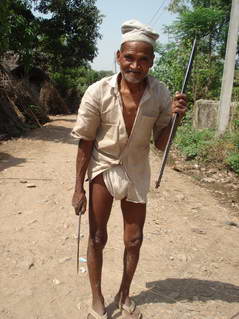
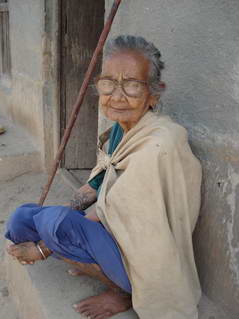 Among
these, a view suggests that the term Tharu is derived from 'Sthera'
which represents a sect of Buddhists. According to the second view, the
word 'Tharu' is derived from the word 'Thara' of Magar language, which
means the plain. The third view suggests that the people who have come
from Thar in Rajasthan, India are called Tharu. No view among these has
been attested yet, although all of these have equal possibility to be
proved true. However, there are other views too.
Among
these, a view suggests that the term Tharu is derived from 'Sthera'
which represents a sect of Buddhists. According to the second view, the
word 'Tharu' is derived from the word 'Thara' of Magar language, which
means the plain. The third view suggests that the people who have come
from Thar in Rajasthan, India are called Tharu. No view among these has
been attested yet, although all of these have equal possibility to be
proved true. However, there are other views too.
Settlement and Population
Tharu people are found in the
southern belt of Nepal called Terai from the east through the west and
the adjacent valleys and plains between the Chure hilly ranges called
inner Terai. Namely Jhapa, Morang, Sunsari, Saptari, Siraha, Mahottari,
Sarlahi, Rautahat, Bara, Parsa, Udayapur, Chitwan, Nawalparasi,
Rupandehi, Kapilbastu, Dang, Banke, Surkhet,
 Bardiya,
Kailali, Kanchanpur districts of Nepal are the settlement areas of Tharu
people.The total population of Tharu folk group is 15,33,879. Among
these, 1,47,323 people live in Dang and Deukhuri valleys. Among 39
Village Development Committees (VDCs) and 2 Municipalities, there is the
majority of Tharu folk group except 5 hilly VDCs.
Bardiya,
Kailali, Kanchanpur districts of Nepal are the settlement areas of Tharu
people.The total population of Tharu folk group is 15,33,879. Among
these, 1,47,323 people live in Dang and Deukhuri valleys. Among 39
Village Development Committees (VDCs) and 2 Municipalities, there is the
majority of Tharu folk group except 5 hilly VDCs.
Most of the Tharu people are known in terms of the territory they have occupied or they have migrated from. The Tharus settled from Jhapa to Udayapur districts in the eastern Nepal are known as Purbiya (Eastern) Tharu. The Tharus settled in Chitwan District are known as Chitaunya Tharu. Tharus from Nawalparasi to Kanchanpur Districts are known as Dangwa Tharu. Tharus of Deukhuri are known as Deukharya Tharu. Tharus in the Sunar area of Banke District are called Solahrya Tharu. Tharus settled in the border of India are called Deshaurhya. Tharus lived in king's land and Rana's hunting areas are known as Rajhatya Tharu. Tharus come from India are known as Rana, Katharya. And, Tharus migrated from Dang Districts and settled in Surkhet, Kapilvastu, Banke, Bardiya, Kailali, Kanchanpur are called Dangaura. However, there are six clans of Tharu viz. Madwa, Dahit, Pachhaladangya, Demandaura, Kusumya. These clans are further divided into many sub-clans.
House Construction and Use
Tharu people choose plain lands
at the jungle side or river side for house construction. They like to
settle in a group of their own community members, thus the houses are
found dense within a small area. The traditional house is constructed in
the land with north-south length and east-west width. The wall of the
house is build with mud and the roof is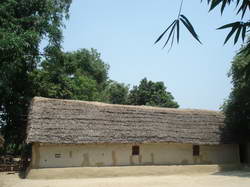 thatched
with grass. There
is a passage called
'piryari'
at the
centre
inside the house which is used to
enter into the rooms around it. The rooms are situated east and west of
the passage. The north-eastern room is used as god's room and
north-western
room is used as
kitchen.
'Chikthi'
is hang on the
ceiling of the
kitchen to put foods and
vegetables. The next room situated to the south of the god's room is the
bed room of the chief of the house in which no other member of the
family can sleep. Southern most room is used to keep domestic animals.
The bed rooms vary depending on the number of the family members.
However, the traditional houses are disappearing.
thatched
with grass. There
is a passage called
'piryari'
at the
centre
inside the house which is used to
enter into the rooms around it. The rooms are situated east and west of
the passage. The north-eastern room is used as god's room and
north-western
room is used as
kitchen.
'Chikthi'
is hang on the
ceiling of the
kitchen to put foods and
vegetables. The next room situated to the south of the god's room is the
bed room of the chief of the house in which no other member of the
family can sleep. Southern most room is used to keep domestic animals.
The bed rooms vary depending on the number of the family members.
However, the traditional houses are disappearing.
Tharu Language
Tharu' is the ethnonym for the
language spoken by Tharu folk group. Tharu is spoken as a first language
and Nepali is spoken as a second language by Tharu people. At the same
time other people residing among the Tharu community speak tharu. The
language is used in the social and cultural domains of their daily life,
such as among the community members, at work places, within the family,
at the rites and rituals etc. Tharu language was introduced 3-4 years
ago in the formal mother tongue education system on the basis of the
textbooks developed by Curriculum Development Centre, Ministry of
Education, government of Nepal. But, it was stopped later on. It is
written in Devanagari script and folk tales, tales of the origin, folk
epics, etc. have been published. The language is also used in the media such as
magazines, newspapers, and F.M. radios. Among the Tharu people very few
are monolingual, some are bilingual and some are multilingual speakers.
Nepali, Hindi, and English are the other languages spoken by these
bilingual or multilingual Tharu people. The language shift has not been
felt strong yet in the community, though the competence on the language
has found gradually decreasing among the young generation. Code mixing
and switching is found among the community. Tharu people are found loyal
to their language.
have been published. The language is also used in the media such as
magazines, newspapers, and F.M. radios. Among the Tharu people very few
are monolingual, some are bilingual and some are multilingual speakers.
Nepali, Hindi, and English are the other languages spoken by these
bilingual or multilingual Tharu people. The language shift has not been
felt strong yet in the community, though the competence on the language
has found gradually decreasing among the young generation. Code mixing
and switching is found among the community. Tharu people are found loyal
to their language.
Tharu language has 29 consonants and 8 vowels. Nasalization is also contrastive in this language. Tharu has two number (singular-plural) and two gender (feminine-masculine) system. There are nominal classifiers in the language. Ergative, instrumental, accusative, dative, genitive, and locative cases are marked with suffixes in the language. There are three tenses (past, present, and future), and four moods (indicative, interrogative, imperative, and optative) found in the language. Tharu is a S(ubject)-O(bject)-V(erb) language which have interrogation, negation, causativization, and passivization syntactic processes. Subordination and Coordination as clause combining processes found in the language.
Family, kinship, gender issues and the decision making
Tharu people used to live in
joint family traditionally and it is practiced up to now. It is supposed
to come into p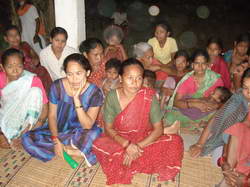 ractice
because of t
ractice
because of t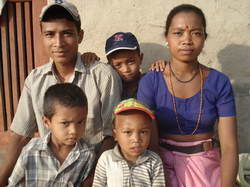 he
agricultural life they live. However, nucleus families are also found
now a day as with the occupation is being changed. A girl goes to her
husband's house after marriage because the Tharu is a patriarchal
community. The chief of
the house is
called
'gardhurya'
who is a male
member of the
family, and he is the decision
maker. There used to be the practice of polygamy in the past. However,
this is not practiced these days. The man who lives in the
father-in-law's house is supposed to be inferior in the community. As a
result, no one likes to stay in his father-in-law's house. Two types of
kinship is found in Tharu community, i.e.,
he
agricultural life they live. However, nucleus families are also found
now a day as with the occupation is being changed. A girl goes to her
husband's house after marriage because the Tharu is a patriarchal
community. The chief of
the house is
called
'gardhurya'
who is a male
member of the
family, and he is the decision
maker. There used to be the practice of polygamy in the past. However,
this is not practiced these days. The man who lives in the
father-in-law's house is supposed to be inferior in the community. As a
result, no one likes to stay in his father-in-law's house. Two types of
kinship is found in Tharu community, i.e.,
established through blood relationship and marriage relationship.
Folk Belief
There are popular folk beliefs
about good omen, bad omen, arrival of the guests, raining, evil eyes,
death, etc. Nes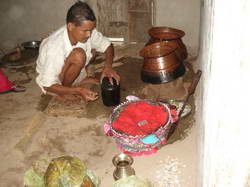 t
of pigeon and shallow in the house is taken as a good omen among the
Tharu people. If the chicken crow in the night time, the owl owls, the
vulture sits at the house, the dog barks unnaturally, a man's left eye
and a woman's right eye flickers, the muscle in the body flickers, and
an object falls from the hand; the Tharu people believe these events as
bad omen. The Tharu folk group believes that the fighting of cocks/hens
and crowing of the crow are the signs of arrival of the guests.
t
of pigeon and shallow in the house is taken as a good omen among the
Tharu people. If the chicken crow in the night time, the owl owls, the
vulture sits at the house, the dog barks unnaturally, a man's left eye
and a woman's right eye flickers, the muscle in the body flickers, and
an object falls from the hand; the Tharu people believe these events as
bad omen. The Tharu folk group believes that the fighting of cocks/hens
and crowing of the crow are the signs of arrival of the guests.
Black and red cloud in the sky, and wind from the east are believed as the signs of rain while the wind from the west is taken as the sign of no rain. The Tharu people believe that the Hansli (a small curved knife with handle) with a piece of their own naval tied on the waist prevents the baby from the evil eyes. Likewise a hansya (curved knife with handle) kept with her prevents the new mother from the evil eyes according to their belief.
There are also some taboos among the Tharu community such as one should not touch wife's elder sister and younger brother's wife, a woman should not stay in the dihurar (god's room) during the period of delivery, and one should not tell mantras (chants) to other people.
Folk Gods and Goddess, and Folk Religious Ceremonies
There are god and evil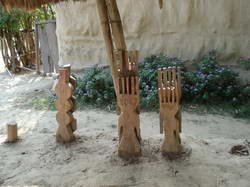 powers worshipped by the Tharu community. Some of these are related to
Hindu mythology, some others are placed in the local shrines, some are
worshipped in some rituals and religious works. Kherabri is the famous
saint known as Narada Rishi and Dhamarjwa is the king of justice known
as Dharmaraja who is supposed as the determiner of the dead person
whether s/he has to go to the hell or heaven in the Hindu mythology.
powers worshipped by the Tharu community. Some of these are related to
Hindu mythology, some others are placed in the local shrines, some are
worshipped in some rituals and religious works. Kherabri is the famous
saint known as Narada Rishi and Dhamarjwa is the king of justice known
as Dharmaraja who is supposed as the determiner of the dead person
whether s/he has to go to the hell or heaven in the Hindu mythology.
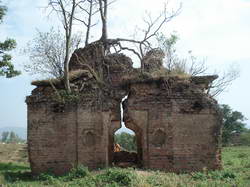 There
is an ancestral god called Gurbaba who is supposed to be the first Tharu
man. Gurbaba is important in terms of the Tharu's own myth
of origin. The
local shrines are called
thanhawa
where
the gods and goddess are placed and worshipped.
Chawahwa
and
Daharchandi
are the husband and wife god and goddess established in
the shrine, respectively.
Jogethwa
is the
saint god established in the shrine and
Pitornya
or
Pitrain
is the
goddess established in the
shrine. While a Tharu chief of the family performs some religious
ceremony they ask for permission from the god Saunra. They establish and
worship the idol of the animals and other creatures in the earth like
horse and snake.
Masan
and
churinya
are the
spirit of the man
and woman who died untimely.
There
is an ancestral god called Gurbaba who is supposed to be the first Tharu
man. Gurbaba is important in terms of the Tharu's own myth
of origin. The
local shrines are called
thanhawa
where
the gods and goddess are placed and worshipped.
Chawahwa
and
Daharchandi
are the husband and wife god and goddess established in
the shrine, respectively.
Jogethwa
is the
saint god established in the shrine and
Pitornya
or
Pitrain
is the
goddess established in the
shrine. While a Tharu chief of the family performs some religious
ceremony they ask for permission from the god Saunra. They establish and
worship the idol of the animals and other creatures in the earth like
horse and snake.
Masan
and
churinya
are the
spirit of the man
and woman who died untimely.
There are several folk religious ceremonies celebrated among the Tharu community. Most of the ceremonies are related to health and prosperity, and farm works. Auli is a worship performed at the field after the paddy is harvested. Khenhwa wahainna is also a worship performed at the yard where the paddy is going to be piled. Karya dahan is performed for prosperity while the fire caught the house of the god or the goddess lost from their place. Ghetauli puja, Dhurra lausar, Durya gurai, Dhuwagar, and Harya gurai are the religious ceremonies performed for the prosperity of the family members, domestic animals, transactions, etc. Some of the worships are performed by the chief of the family while some others are performed by the villagers in a group. her prevents the new mother from the evil eyes according to their belief.
Festivals
Magh, Durheri, Atwari, Ashtimki,
Hardhawa, Dashya,
and
Dewari
are
celebrated as the traditional festivals among
Tharu community.
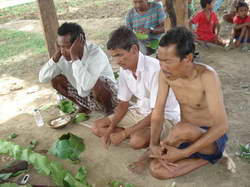 These
festivals are related to the transaction,
prosperity, farm
work, and the entertainment.
Maghi
is
celebrated in the month of Magh
(January-February) as a new
fiscal year and
all the annual transactions are settled.
Dashya
and
Dewari
are the Tharu terms for the great Hindu festivals
celebrated nationwide in Nepal in
the months of October and November respectively which are performed for
the prosperity.
Hardhawa
is
celebrated after the farm work is completed.
These
festivals are related to the transaction,
prosperity, farm
work, and the entertainment.
Maghi
is
celebrated in the month of Magh
(January-February) as a new
fiscal year and
all the annual transactions are settled.
Dashya
and
Dewari
are the Tharu terms for the great Hindu festivals
celebrated nationwide in Nepal in
the months of October and November respectively which are performed for
the prosperity.
Hardhawa
is
celebrated after the farm work is completed.
Durheri is the festival of colors known as Holi and celebrated in Nepal and India widely basically for the entertainment. Atwari and Astimki are also celebrated with fasting for the prosperity.
Folk food and drinks
Food items made of rice and wheat
are the main courses and the drinks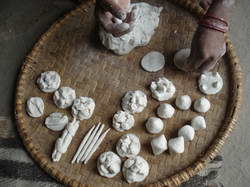 made of the fermented grains are the drinks of Tharu traditional food
and drinks. Besides, they include fish and shells in their traditional
food. The Tharu foods can be classified into ordinary food and special
foods which are consumed in the daily life and the feasts and festivals,
respectively.
made of the fermented grains are the drinks of Tharu traditional food
and drinks. Besides, they include fish and shells in their traditional
food. The Tharu foods can be classified into ordinary food and special
foods which are consumed in the daily life and the feasts and festivals,
respectively.
Bhat (cooked rice) and darya (cooked mixture of grinded maize and rice) are the main food items in the daily life of the Tharu people while roti (wheat bread) is taken in the evening in summer season. Other items in the ordinary food are singki (fermented radish) and tina (vegetables) as vegetables, kapwa (gruel) and mar (soup of the types of beans) as soup. Besides, the chutney of the salt and pepper is also a part of the ordinary meal.
Meat,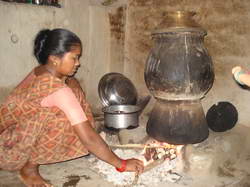 crab, fish, and cell-fish, different types of steamed and oiled food
items made of rice flour are the special traditional foods among the
Tharu community. Pork is a special item among meat though there is
mutton, chicken, and other animal's
meat like pigeon
and other wild animals and birds.
Dhikri
is
made from steamed rice flour and
roti is different types of oiled rice flour. There is also dried fish as
special food item. The special food items are either consumed in feast
and festivals or taken to the relatives as present.
crab, fish, and cell-fish, different types of steamed and oiled food
items made of rice flour are the special traditional foods among the
Tharu community. Pork is a special item among meat though there is
mutton, chicken, and other animal's
meat like pigeon
and other wild animals and birds.
Dhikri
is
made from steamed rice flour and
roti is different types of oiled rice flour. There is also dried fish as
special food item. The special food items are either consumed in feast
and festivals or taken to the relatives as present.
Janr, jhwar, mad are made of fermented cooked rice which are the popular traditional alcohal among Tharu community. The alcohal are used in daily life as well as special occasions.
Folk Dresses and Ornaments
Tharu people use their own
traditional dresses
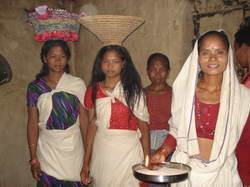 which
can be classified into the dresses for daily use and the dresses for
special use. Tharu mothers prepare special cap for their children
which covers ears
and protect from cold. This is called
topi.
Tharu men wear
kattu
(a kind of half
pants used as under garment),
dagli
(an
upper garment made of thick cotton with lace to knot at the front),
pichauri
(a kind of wrapper to cover
the upper part of the body which
is used in the cold), and
bhegwa
(a kind
of wrapper to cover the lower part of the body
it functions like sari but the
style and colour are different).
which
can be classified into the dresses for daily use and the dresses for
special use. Tharu mothers prepare special cap for their children
which covers ears
and protect from cold. This is called
topi.
Tharu men wear
kattu
(a kind of half
pants used as under garment),
dagli
(an
upper garment made of thick cotton with lace to knot at the front),
pichauri
(a kind of wrapper to cover
the upper part of the body which
is used in the cold), and
bhegwa
(a kind
of wrapper to cover the lower part of the body
it functions like sari but the
style and colour are different).
Tharu female wear cholya (an upper garment with lace to knot at the front), gatya (a kind of wrapper to cover the upper part of the body which is wrapped from the back and knotted at the front),
gonya (a kind of wrapper to cover the lower part of the body), dainahawa jhulwa (a kind of upper garment like dagli), lahanga and lungi (kinds of wrapper to cover the lower part of the body).
There are some special garments which are used only in folk performing arts especially folk drama and folk dance. Ghurghut is used to cover head by the female dancer or the male dancer in women's role while performing folk dance. Phankani is used on the front part of the body between the shoulders while sataki is a red piece of cloth wrapped around the front lower part of the waist. Both of these are used with lahanga.
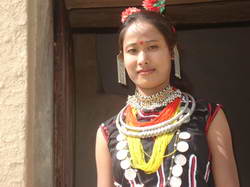
Tharu women are decorated with different types of ornaments from head to foot. They put tikali and mangya on their forehead. They use jhobanha to tie the hairs at the back. They wear chhetaur, jhimalya, jhumkaha winr, tap and lurki on their ears, and nathya, phuli, phonphi on their nose. They wear kansrehi, gataiya, gurya, taunk, mala, sutya and humel as artistic necklaces. They decorate their arms with rings called tanrya, banka and bijayat, and their wrist with kankani, churya and bala. They wear mundri on their fingers (hand). They wear churwa, payanri on their ankles and bhichhiya at the second toe.
However, now days, Tharu people have started using modern fashion like shirt, pants, t-shirt, blouse, kurta, suruwal, etc.
Folk Medical Treatment
Tharu folk group has different
traditional ways of medical treatments.
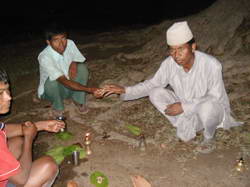 Aches
like headache, toothache, stomachache, etc.; animal bites like dog bite,
fox bite, snake bite, etc.; wounds; fever, measles; infection in the
eyes; allergy; pain; gastric; and other diseases, infections, pains, and
wounds are cured with the herbal medicines available in their territory.
Fruits, barks, leaves, flowers, roots etc. of the mango, plum, lotus,
black pepper, barley, onion, garlic, ginger, banana, etc. are used in
the Tharu folk medical treatments.
Aches
like headache, toothache, stomachache, etc.; animal bites like dog bite,
fox bite, snake bite, etc.; wounds; fever, measles; infection in the
eyes; allergy; pain; gastric; and other diseases, infections, pains, and
wounds are cured with the herbal medicines available in their territory.
Fruits, barks, leaves, flowers, roots etc. of the mango, plum, lotus,
black pepper, barley, onion, garlic, ginger, banana, etc. are used in
the Tharu folk medical treatments.
Folk Literature
Tharu folk group is rich in terms
of its folk literature. There are folk songs, ballades, folk epics, folk
tales, proverbs, and riddles as the parts of life of the Tharu
community. Tharu folk songs are further classified into general, ritual,
festival, seasonal, and work songs. The general folk songs are
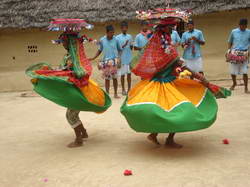 sung
any time irrespective of rites and rituals, seasons, festivals
etc.
Baramasya, hurdungya, jhumara, lagni git, kathorya,
and
chhokra git
are general songs. Most of these songs are sung
with dance. Tharu ritual folk
songs are related to marriage
ceremony.
Diuli
darna magar
is sung during the initial stage of the marriage ceremony
for the prosperity.
Janti parchhaber
gaina magar
is sung to welcome bridegroom which is also sung for the
prosperity.
Chauthyar git
is sung while the
bride
comes back first time to her
maternal house after the marriage.
sung
any time irrespective of rites and rituals, seasons, festivals
etc.
Baramasya, hurdungya, jhumara, lagni git, kathorya,
and
chhokra git
are general songs. Most of these songs are sung
with dance. Tharu ritual folk
songs are related to marriage
ceremony.
Diuli
darna magar
is sung during the initial stage of the marriage ceremony
for the prosperity.
Janti parchhaber
gaina magar
is sung to welcome bridegroom which is also sung for the
prosperity.
Chauthyar git
is sung while the
bride
comes back first time to her
maternal house after the marriage.
Tharu festival songs are related to the festivals maghi, dhurheri, astimki, and dusya. Dhumru is sung in the last night of the month of Poush (just before the month of Magh starts) while maghauta is sung during the month of Magh. Phag paharna is sung during the festival Dhurheri. Ashtimki git is sung at the festival Ashtimki which is the birth day of the Hindu god Krishna.
barkimar, sakhya, and paiyan are sung during dusya (the great Hindu festival Dashain). Sajana and maina are the Tharu seasonal songs both are sung during the summer season. Ban
gitwa
is the
only Tharu song related to work which is sung at
farm works like in the farm,
jungle, etc.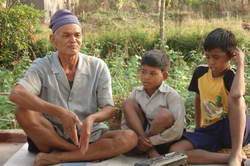
There are four popular ballades among Tharu people – madho-sundari, lakhi, chhita ranik maina, and raunak painyan. Madho-sundari is based on a love of a hero Madho and a heroine Sundari. Lakhi is based on the story of brave Tharu lady Lakhi. Chhita ranik maina seems very close to the story of Sita, the heroine of the great Sanskrit epic Ramayana. Finally, Raunak painyan is based on the story of Ravana, villain of the great Sanskrit epic Ramayana. Though these ballades seem to have the common source with Ramayan, these are localized and the stories are modified too.
There are four folk epics popular among the Tharu people – gurubabak jarmauti, ramvihegra, sakhya, and barkimar. Among these first is the myth of origin, second is based on Ramayana, and third and fourth are based on Mahabharata. Tharu folk tales have both the man and the animal characters. The message conveyed through the tales is the ethical lessons. The behavior of the characters and the relations among them covertly presents the lessons. However, some of the tales do not have such ethical lessons which are used only for the entertainment.
Tharu proverbs and riddles have the contents from the Tharu society and culture and are popularly practiced.
Folk Performing Arts and drawings
Tharu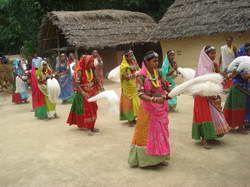 performing arts can be classified into folk drama
and folk dance.
Gaiya berhana
and
magha lotana
are the
folk dramas popular among Tharu
people. Both of these are performed to get rain while there is no rain
in rainy season. Both of these are performed at night by the naked
people with the vulgar songs sung in a group. First of these is
performed by women while the second is performed by men. Folk dances
practiced among Tharu people can be classified into dances with songs
and dances without songs. The songs mentioned in the Tharu folk songs
are practiced with dances so these can be called dances with songs.
performing arts can be classified into folk drama
and folk dance.
Gaiya berhana
and
magha lotana
are the
folk dramas popular among Tharu
people. Both of these are performed to get rain while there is no rain
in rainy season. Both of these are performed at night by the naked
people with the vulgar songs sung in a group. First of these is
performed by women while the second is performed by men. Folk dances
practiced among Tharu people can be classified into dances with songs
and dances without songs. The songs mentioned in the Tharu folk songs
are practiced with dances so these can be called dances with songs.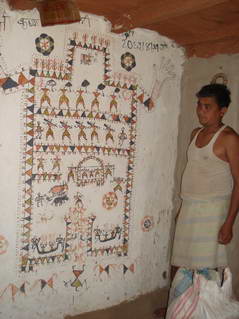 The
folk dances
without song are
painya nach,
lattha dance, barka nach,
and
dholaha nach.
Painyan nach
is performed by Tharu women in a group in
dusya
festival.
Lattha nach
is a special
dance with stick in hands and
peacock feathers at the back performed traditionally by Tharu men in a
group. However, it
is also performed
by Tharu women now days.
Barka nach
is
practiced in Deukhuri valley by
Tharu women which is similar.
The
folk dances
without song are
painya nach,
lattha dance, barka nach,
and
dholaha nach.
Painyan nach
is performed by Tharu women in a group in
dusya
festival.
Lattha nach
is a special
dance with stick in hands and
peacock feathers at the back performed traditionally by Tharu men in a
group. However, it
is also performed
by Tharu women now days.
Barka nach
is
practiced in Deukhuri valley by
Tharu women which is similar.
Folk Musical Instruments
Tharu
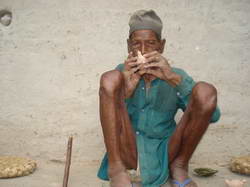 folk
musical instruments can be classified as the drums, cymbals, flutes, and
the bell. There are two types of drums which are made of wood and
leather. Both of these
are long drums.
Dhol
is a big drum while
madra
is a
small drum.
Kastar jhal, majira,
and
chatkoli
are different kinds of cymbals.
Jhal
and
majira
are made of metal,
kastar
is made
of wood and metal plates, and
chatkoli
is made
of bamboo pieces.
Basya
and
pilhru
are flute like blowing instruments.
Basya
is made
of bamboo or metal while
pilhru
is made
of clay in the shape of bird.
Kole
is a
bell which is hang on the
waist and played.
to
painyan nach
practiced by Tharu women in Dang valley.
The dance based on Mahabharata
epic and practiced by Tharu
men in Dang valley
is also called
barka nach.
Dholaha nach
is
performed by Tharu men in women's
dress with sword in hand at marriage ceremony. A member of a dancer's
team beats
the drum
(called
dhol).
folk
musical instruments can be classified as the drums, cymbals, flutes, and
the bell. There are two types of drums which are made of wood and
leather. Both of these
are long drums.
Dhol
is a big drum while
madra
is a
small drum.
Kastar jhal, majira,
and
chatkoli
are different kinds of cymbals.
Jhal
and
majira
are made of metal,
kastar
is made
of wood and metal plates, and
chatkoli
is made
of bamboo pieces.
Basya
and
pilhru
are flute like blowing instruments.
Basya
is made
of bamboo or metal while
pilhru
is made
of clay in the shape of bird.
Kole
is a
bell which is hang on the
waist and played.
to
painyan nach
practiced by Tharu women in Dang valley.
The dance based on Mahabharata
epic and practiced by Tharu
men in Dang valley
is also called
barka nach.
Dholaha nach
is
performed by Tharu men in women's
dress with sword in hand at marriage ceremony. A member of a dancer's
team beats
the drum
(called
dhol).
There are two folk drawings practiced among the Tharu people ashtimki and godna. Ashtimki is based on Tharu myth of origin and the drawings are performed in the wall inside the meeting room at the ashtimki festival. Godna is drawings on the lower part of the knees of Tharu women. It is a kind of tatoo and a means of decoration for married women.
Folk games and entertainments
There are children's games
popular among
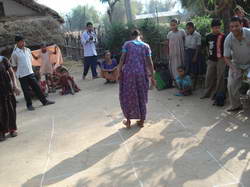 Tharu
people. Most of the games are practiced by the girls.
Rabarbyang, dori
hallawa,
and
phatphatya
are the
games played jumping over the rope by Tharu girls.
Chikani
is
played with the boxes drawn on the yard, and
chari
is
played with small pieces of stones both by the girls.
Laribeti
is the
game for Tharu boys.
Tharu
people. Most of the games are practiced by the girls.
Rabarbyang, dori
hallawa,
and
phatphatya
are the
games played jumping over the rope by Tharu girls.
Chikani
is
played with the boxes drawn on the yard, and
chari
is
played with small pieces of stones both by the girls.
Laribeti
is the
game for Tharu boys.
Folk tools and weapons
Tharu people make and use tools
and weapons made of wood, metal, stone, bamboo, leaf, etc. Widely used
wooden tools and weapons among the T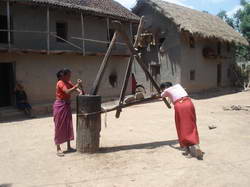 haru
community are plough, yoke, stick, oil mill, mortar and pestle to grind
salt and pepper, spinning tools, tool for levelling after ploughing the
field, hammer, carrying stick, and handles for different tools and
weapons. Tharu people use stone mortar and pestle as well as grinding
stone. The metal tools and weapons made and used by Tharu people are
axe, spade, needle, hook, different types of knives, etc. Tharu people
make and
use also different
kinds of bamboo tools and weapons.
Khandra
is a
tool to catch rats.
Khongdhya, tip,
and
dharya
are the tools to
catch fish, crab etc.
Chhitni
and
chhitwa
are the baskets to store goods; and
bakhari
is used
to store grains.
Delya
is
used to put caught fishes and
crabs. They also make and use
hand fan called
byana.
Leaf plates of different shapes and sizes
are other tools made and used by
Tharu people. Clay pots and
vesels like
karai,
kuthali, khonteli, khondhwa, gumra, golra, chundawa, dehri, bhokti,
saidra
etc. which are used in the
different purposes such as to
store food and food grains, to make, store, and drink traditional
drinks, etc.
haru
community are plough, yoke, stick, oil mill, mortar and pestle to grind
salt and pepper, spinning tools, tool for levelling after ploughing the
field, hammer, carrying stick, and handles for different tools and
weapons. Tharu people use stone mortar and pestle as well as grinding
stone. The metal tools and weapons made and used by Tharu people are
axe, spade, needle, hook, different types of knives, etc. Tharu people
make and
use also different
kinds of bamboo tools and weapons.
Khandra
is a
tool to catch rats.
Khongdhya, tip,
and
dharya
are the tools to
catch fish, crab etc.
Chhitni
and
chhitwa
are the baskets to store goods; and
bakhari
is used
to store grains.
Delya
is
used to put caught fishes and
crabs. They also make and use
hand fan called
byana.
Leaf plates of different shapes and sizes
are other tools made and used by
Tharu people. Clay pots and
vesels like
karai,
kuthali, khonteli, khondhwa, gumra, golra, chundawa, dehri, bhokti,
saidra
etc. which are used in the
different purposes such as to
store food and food grains, to make, store, and drink traditional
drinks, etc.
Folk skill and Technology
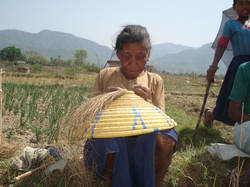
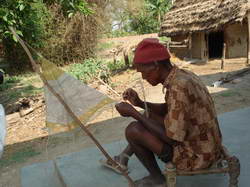 All
the traditional tools and weapons that are used by Tharu people are
prepared by themselves. Besides, they make different
types of baskets
called
delwa, dhakli, dhakya, bhauka, panchhopni, painastopi,
wenrra,
and
supli
from
grass which
are used to put the goods, to
cover water pot and prepared foods, to support the pots with not flat
bottom, and also to use in the decoration. Some of these baskets are
colored with different colors and decorated with shells, peacock's
feathers, etc. which look so beautiful.
All
the traditional tools and weapons that are used by Tharu people are
prepared by themselves. Besides, they make different
types of baskets
called
delwa, dhakli, dhakya, bhauka, panchhopni, painastopi,
wenrra,
and
supli
from
grass which
are used to put the goods, to
cover water pot and prepared foods, to support the pots with not flat
bottom, and also to use in the decoration. Some of these baskets are
colored with different colors and decorated with shells, peacock's
feathers, etc. which look so beautiful.
Tharu people prepare traditional drinks themselves. They use different types of clays, herbals and stones to wash and bath. They sew the cloths and embroider. They prepare nets and traps and catch fish and birds. These are the Tharu folk skills and technologies.
Economic Life and Livelihood
The large part of the Tharu
economy depends
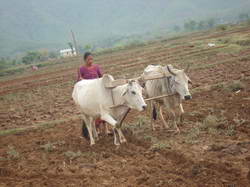 on
agriculture, which depends on the rain. That is not much reliable and
profitable. The farm works are traditional. Tharu people use plough and
spade. They use organic fertilizer, basically dung. They grow paddy,
wheat, barley, gram, mustard, potato, cauliflower, onion, pumpkin, etc.
They keep cows, buffaloes, goats, sheep, pigs, chickens, etc. So the
farm and animal products are the major sources of income and bases of
the economic life. However, very few of the Tharu people have started
other professions now days.
on
agriculture, which depends on the rain. That is not much reliable and
profitable. The farm works are traditional. Tharu people use plough and
spade. They use organic fertilizer, basically dung. They grow paddy,
wheat, barley, gram, mustard, potato, cauliflower, onion, pumpkin, etc.
They keep cows, buffaloes, goats, sheep, pigs, chickens, etc. So the
farm and animal products are the major sources of income and bases of
the economic life. However, very few of the Tharu people have started
other professions now days.
Rites of the Passage
T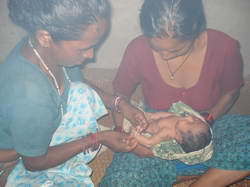 here
are three main rites of the passage among Tharu
folk group, namely
birth, marriage, and death.
Sorahiniya
(who
functions as midwife) should be
present while a mother gives
birth to her
child.
Sorahiniya
cuts the umbilical
cord which is buried at the corner of
bahari kwatha
(meeting room). Unless
the newly mother is purified, no
male member can see the baby. There is no fix day for purification. When
the navel falls then the mother is purified. There is feast on the day
of purification. There is worship and chicken is slaughtered. The
Sorahiniya
is
invited and served foods with respect.
Lausari puja
is performed within a month after the birth of the baby
then the new mother is free to
move around and meet the people. There was a child marriage among the
Tharu community in the past, however it is not in practice now. Marriage
is
called
bhwaj
in Tharu.
here
are three main rites of the passage among Tharu
folk group, namely
birth, marriage, and death.
Sorahiniya
(who
functions as midwife) should be
present while a mother gives
birth to her
child.
Sorahiniya
cuts the umbilical
cord which is buried at the corner of
bahari kwatha
(meeting room). Unless
the newly mother is purified, no
male member can see the baby. There is no fix day for purification. When
the navel falls then the mother is purified. There is feast on the day
of purification. There is worship and chicken is slaughtered. The
Sorahiniya
is
invited and served foods with respect.
Lausari puja
is performed within a month after the birth of the baby
then the new mother is free to
move around and meet the people. There was a child marriage among the
Tharu community in the past, however it is not in practice now. Marriage
is
called
bhwaj
in Tharu.
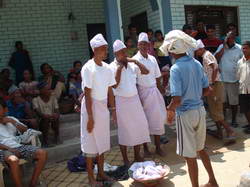 Aguwa
(the mediater) has an important role in the Tharu traditional marriage.
Aguwa
arranges the
meetings of the two parties of
the marriage and mediates to
proceed ahead.
Ghar herna
(to see the house, by the other
side of the proposed marriage) is
held in the month of Magh and the marriage is performed in the month of
Phagun (the following month). The marriage is held on Wednesday,
traditionally but it is also held on Sunday and Friday at the night. A
lady either aunt or sister in law (elder brother's wife)
functions as
bhojiniya
in the marriage ceremony. Unless the
bhojiniya
collides the heads of the bride and bridegroom, the marriage is not
complete. So
bhojiniya
has important role
in
the marriage. The bridegroom
wears traditional white dress during marriage ceremony. Both the men and
women participate in the marriage procession. There is a feast with
pork, mutton or chicken and drinks in the marriage. Besides, there are
other kinds of marriage also in practice now a days. When a person dies
all the people come to observe the dead body in Tharu community. The
dead body is carried to the river side on the upside down cot. A priest
carries husked
rice, maize and
tina
to the grave. Only male members participate
in the funeral procession.
Purification is performed within thirteen days, often held on Thursday
or Monday. Purification is completed after shaving the head, and getting
oil from the priest. There is a feast with cooked rice, black lentil,
pork and fish which are supposed to be purification items.
Aguwa
(the mediater) has an important role in the Tharu traditional marriage.
Aguwa
arranges the
meetings of the two parties of
the marriage and mediates to
proceed ahead.
Ghar herna
(to see the house, by the other
side of the proposed marriage) is
held in the month of Magh and the marriage is performed in the month of
Phagun (the following month). The marriage is held on Wednesday,
traditionally but it is also held on Sunday and Friday at the night. A
lady either aunt or sister in law (elder brother's wife)
functions as
bhojiniya
in the marriage ceremony. Unless the
bhojiniya
collides the heads of the bride and bridegroom, the marriage is not
complete. So
bhojiniya
has important role
in
the marriage. The bridegroom
wears traditional white dress during marriage ceremony. Both the men and
women participate in the marriage procession. There is a feast with
pork, mutton or chicken and drinks in the marriage. Besides, there are
other kinds of marriage also in practice now a days. When a person dies
all the people come to observe the dead body in Tharu community. The
dead body is carried to the river side on the upside down cot. A priest
carries husked
rice, maize and
tina
to the grave. Only male members participate
in the funeral procession.
Purification is performed within thirteen days, often held on Thursday
or Monday. Purification is completed after shaving the head, and getting
oil from the priest. There is a feast with cooked rice, black lentil,
pork and fish which are supposed to be purification items.
Concluding Remarks
Tharu is one of the ethnic groups which is rich in terms of own folkore, cultural heritage and language. The folk group is also rich in its traditional skill, knowledge and technology. It has its own way of life and beliefs. Despite these facts, because of the pressure of the globalization and modernization, the folk group is under the threat of shifting the traditional knowledge, skill, technology, culture, belief, ways of life, and by thus the crucial thing their identity. The FOFO study of the Tharu folk group helped the group to be aware towards the preservation of their identity. However, there is a need of further support for them in this direction.
Based on reports of Dr. Govind Archarya, Mr. Ashok Tharu,
Mr. Bir Bahadur Khadka and Mr. Jitendra Kumar Chaudhary
Prepared and translated by: Mr. Bhim Narayan Regmi.